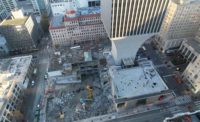The neon sign on top of Denver’s historic Union Station says “Travel by Train,” a reminder of the bygone era when up to 80 trains a day would stop at the busy depot. In recent years, however, the building’s grand waiting room has sat empty except for the few Amtrak passengers waiting to catch the California Zephyr to Chicago or San Francisco.
Today, Union Station, in the city’s Lower Downtown neighborhood, is on the cusp of a major transformation. The Beaux Arts–style depot, built in 1914, is being restored and converted—by Denver firms Tryba Architects and JG Johnson Architects—into a 112-room boutique hotel with shops, offices, and restaurants, opening in July. Meanwhile, in the rail yard behind the station, Skidmore, Owings & Merrill (SOM) has created a multimodal transit hub for buses, light rail, commuter rail, and Amtrak service. The $500 million public-private project is a milestone for sprawling Denver, which has embraced transit in a big way. The metropolitan area’s first light-rail line opened in 1994, and 10 years later, voters approved a $6.5 billion transit program for an additional 122 miles of commuter and light rail. Starting in 2016, Union Station will be the hub for four new commuter lines, including one to Denver International Airport. That “Travel by Train” sign suddenly seems relevant again.
The project’s signature elements, designed by SOM’s Roger Duffy, are a curvy white-fabric canopy that hovers over the train platform and a surprisingly cheerful 980-foot-long underground bus terminal, which opens on May 11. The bus station doubles as a pedestrian concourse that connects an existing light-rail station on the western edge of the 19.5-acre site to the train platform and the terminal. A framework of steel tubes, painted glossy white, supports the 500-foot-long canopy. The structure flares dramatically at the ends and has a long scooped-out section in the middle—a response, Duffy says, to a requirement that views of the historic station remain unobstructed. “One is skeletal and light, the other is heavy and robust. I think they’re very complementary,” he says. The opening, which Duffy calls the “sky hole,” also meant that he didn’t have to add an expensive ventilation system. Given Denver’s 300-plus days of sunshine, complete protection from the elements was deemed unnecessary. The adjacent bus terminal, with 22 bays, replaces a smaller station several blocks away.
Bus stations are typically drab, but SOM’s design makes use of terrazzo floors, yellow tile, and skylights to create an underground space that feels more like an airport concourse than a subterranean transit facility. “It’s a really uplifting, positive experience. I think it brings a sense of nobility that you often don’t get,” says Kristopher Takacs, SOM’s Union Station project manager. Above the terminal is a two-block-long pedestrian plaza with a pavilion at each end—one near the light-rail station, the other near the train platform—connecting commuters to the bus station. (Hargreaves Associates is collaborating with SOM on the site’s landscape design.)
Even before it is completed, the transit hub has already triggered more than $1 billion in private mixed-use development on adjacent property, much of which was also part of the city’s old rail yard. “It’s not just an architectural project,” Takacs says. “It’s a city-building infill project. People want to be in the next great neighborhood, which is right next to a transportation hub.” Takacs estimates that there are 14 development projects in the area currently under construction or in the planning stage.
Urban planner Ken Schroeppel, who blogs about the city’s wave of redevelopment and teaches at the University of Colorado at Denver, adds: “Certainly Union Station is the juggernaut of development in downtown Denver at the moment. And that’s saying a lot, considering how much building is going on throughout the city’s urban core.” Like others, Schroeppel is quick to call Union Station a “game changer” for a city that has already become a model for urban revitalization. “This is going to change the way people in Denver feel about their city,” he says.








Post a comment to this article
Report Abusive Comment